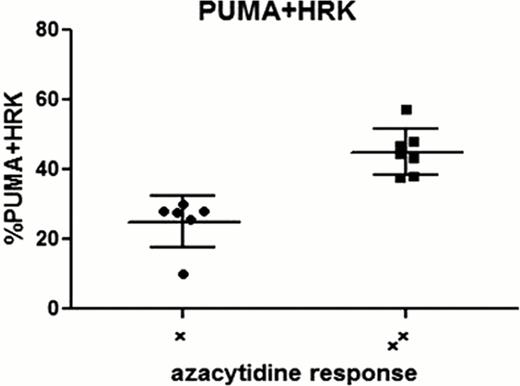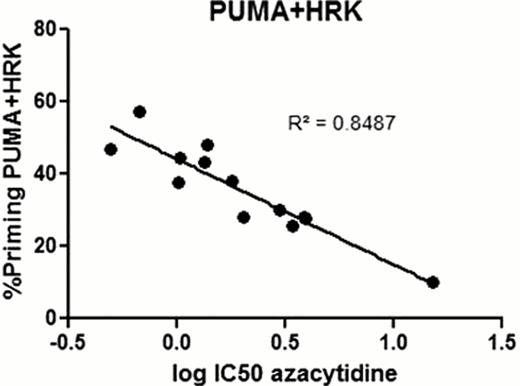Abstract
Abstract 1432
Previously we demonstrated that inhibition of anti-apoptotic BCL-2 family members sensitize leukemic cells to 5-Azacytidine (5-Aza), using siRNA and pharmacological inhibition with the BH3-mimetic ABT-737, both in vitro and ex vivo (Bogenberger, JM., et. al. ASH Annual Abstracts 2011;118:Abstract 3513). Crucially, several anti-apoptotic BCL-2 members (e.g. BCL-2 and BCL-XL) required concurrent inhibition for potent and universal sensitization to 5-Aza. Anti-apoptotic BCL-2 proteins block the execution of programmed cell death (apoptosis) by binding to and counteracting two types of pro-apoptotic BCL-2 family proteins: the “BH3-only” proteins, including both activators (BIM and BID) and sensitizers (e.g. NOXA, PUMA, HRK), and the multi-domain effector proteins (BAX and BAK). Cells dependent on anti-apoptotic BCL-2 family members for survival have been defined as “primed for death” (Certo, M., et. al. Cancer Cell 2006 May;9(5):351-65). Importantly, the priming status reflects a dependence on anti-apoptotic BCL-2 family proteins and can be characterized with the BH3 profiling functional assay. This assay measures induction of mitochondrial outer membrane permeabilization (MOMP) in response to treatment with peptides derived from BH3-only proteins (Ni Chonghaile, T., et. al. Science 2011 Nov 25;334(6059);1129-33). Thus, the unique BH3 profile associated with a specific malignant cell population, is a function of the anti-apoptotic BCL-2 family member/s contextual expression in that cell population. Based on our observations of potent 5-Aza sensitization in combination with anti-apoptotic BCL-2 protein family inhibition, we hypothesized that BH3-profiling would predict response to 5-Aza.
To address the potential utility of BH3 profiling in predicting response to 5-Aza in myeloid malignancies, we assayed a broad panel of AML-derived cell lines (N=13) by BH3 profiling and correlated BH3 metrics with 5-Aza response. Identical cell line passages were assayed by BH3 profiling and in 5-Aza drug dose response assays. The cell panel comprised lines derived from AML FAB subtypes M7, M6, M5, M4, M2 and M0, as well as diverse cytogenetics such as t(11;21), t(9;11), t(4;11), t(6;11), del 5q, del 7, and a broad spectrum of mutations such as FLT3, N-RAS, CDKN2A, NPM1 and DNMT3A. The panel included a normal karyotype AML cell line (CG-SH) (Munker, R., et. al. Leuk Res 2009 Oct:33(10):1405-8) and a blastic cell line derived from a patient with MDS (MDS-L) (Tohyama, K., et. al. Br J Haematol 1994 Jun;87(2):235-42). Partition modeling using several BH3 metrics discriminates 5-Aza response with statistical significance (N=13, Mann-Whitney p<0.01) between more sensitive (EC50<2uM) and less sensitive (EC50>2uM) AML lines. For instance, the Puma BH3 peptide alone distinguishes more sensitive from less sensitive cell lines (N=13, Mann-Whitney p=0.0046). Several more complex parameters, such as “Puma+Hrk”, “Puma+Noxa,” and “Bim+Puma+Noxa+Hrk,” also significantly discriminate 5-Aza response (Mann-Whitney p=0.0011). Using continuous variable analysis, a Puma+Hrk metric exhibited the strongest correlation with 5-Aza response (R2=0.85, p<0.0001), while an individual Puma metric yielded the second strongest correlation (R2=0.70, p=0.0004). In conclusion, BH3 profiling discriminates 5-Aza response and confirms a central role for anti-apoptotic BCL-2 members in 5-Aza response. Furthermore, HRK priming indicates that BCL-XL is an important, although not the sole, anti-apoptotic component determining 5-Aza response in myeloid cells. These BH3 profiling results are in agreement with our functional 5-Aza RNAi and BCL-XL/BCL-2 inhibitor data in combination with 5-Aza. Based on these results, we are currently evaluating BH3 profiles from 5-Aza responding and non-responding AML and MDS patients to validate BH3 profiling-derived metrics in predicting clinical outcomes to 5-Aza.
Pierceall:Eutropics Pharmaceuticals: Employment, Equity Ownership. Lena:Eutropics Pharmaceuticals: Employment. Mesa:Sanofi: Research Funding; Incyte: Research Funding; Lilly: Research Funding; NS Pharma: Research Funding; YM Bioscience: Research Funding. Cardone:Eutropics Pharmaceuticals: Employment, Equity Ownership.
Author notes
Asterisk with author names denotes non-ASH members.



This feature is available to Subscribers Only
Sign In or Create an Account Close Modal